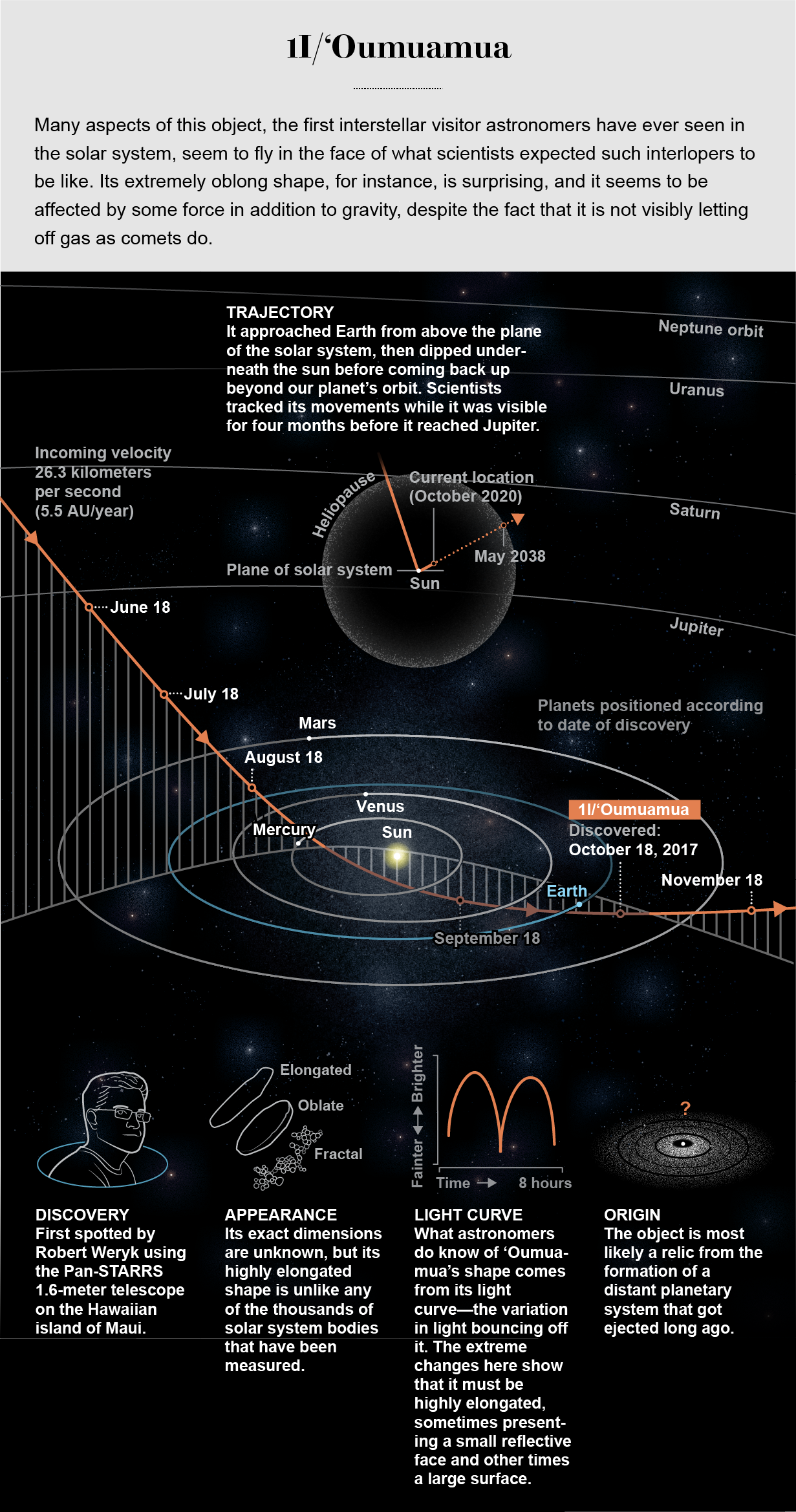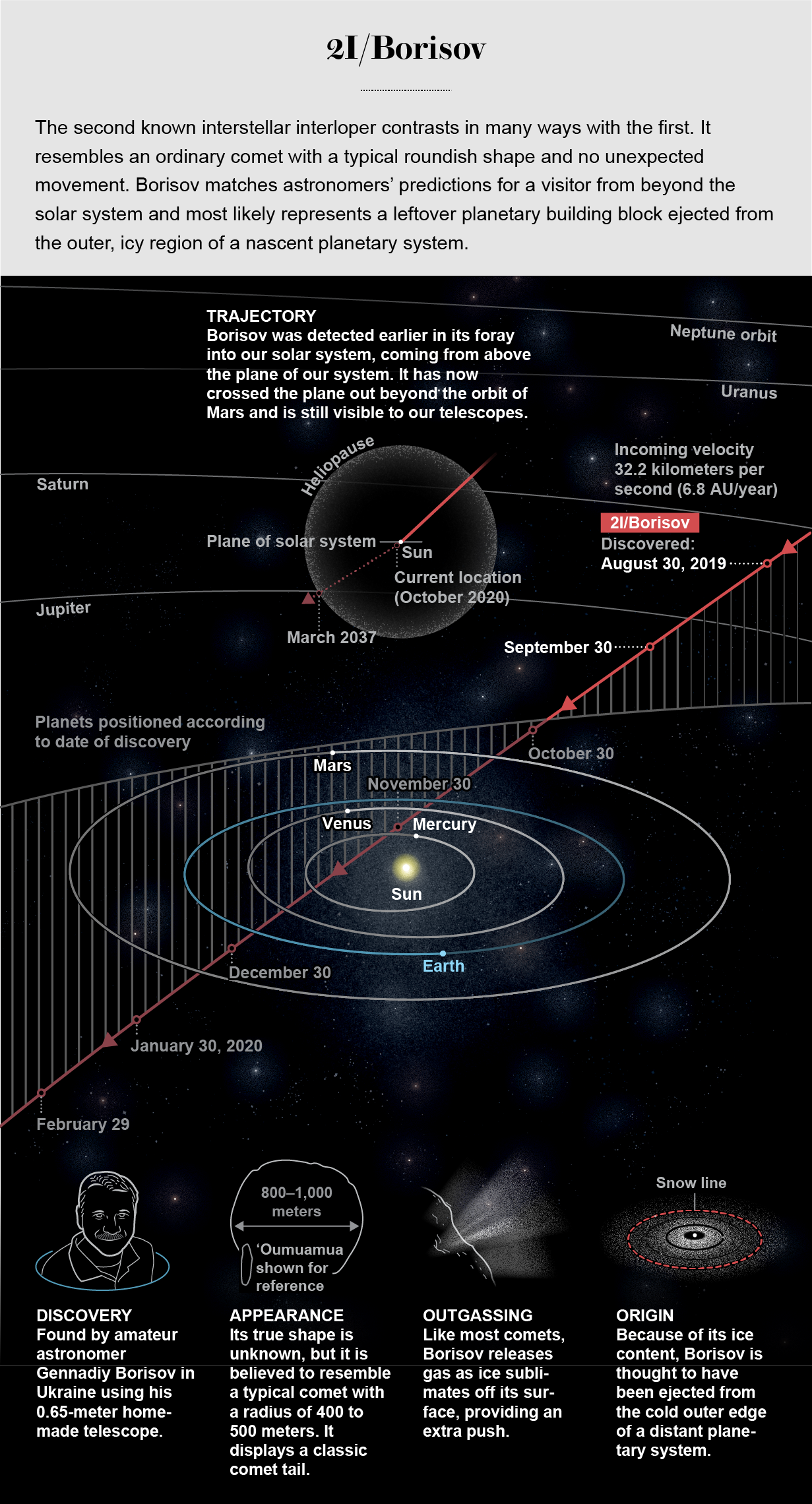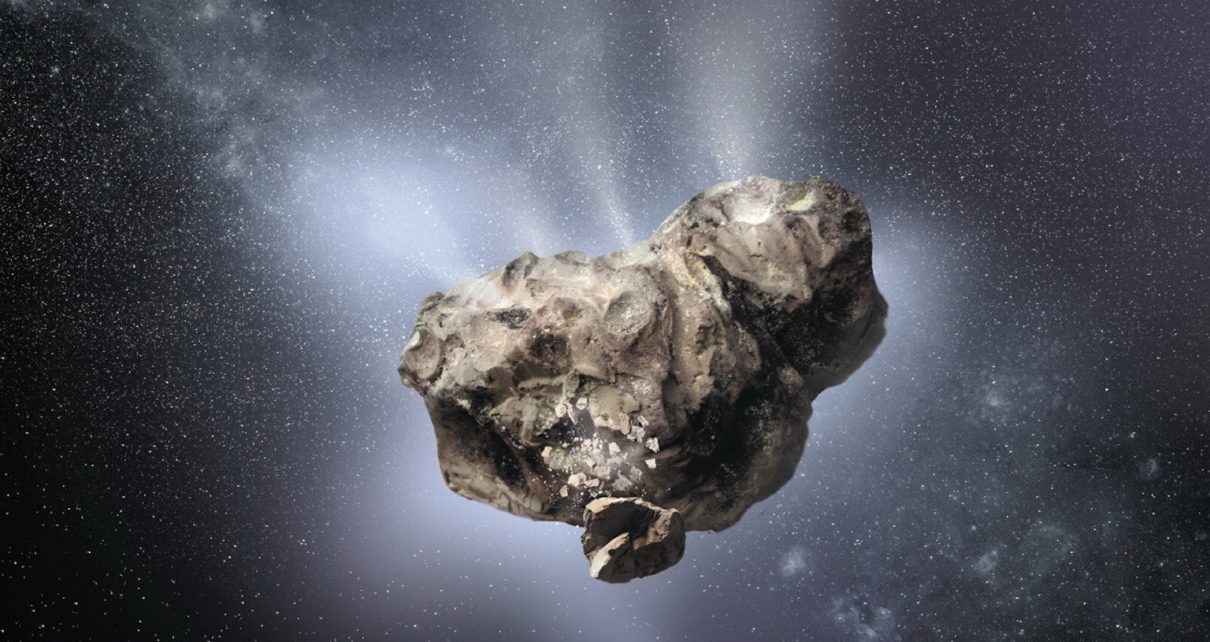Late in the evening of October 24, 2017, an e-mail arrived containing tantalizing news of the heavens. Astronomer Davide Farnocchia of NASA’s Jet Propulsion Laboratory was writing to one of us (Jewitt) about a new object in the sky with a very strange trajectory. Discovered six days earlier by University of Hawaii astronomer Robert Weryk, the object, initially dubbed P10Ee5V, was traveling so fast that the sun could not keep it in orbit. Instead of its predicted path being a closed ellipse, its orbit was open, indicating that it would never return. “We still need more data,” Farnocchia wrote, “but the orbit appears to be hyperbolic.” Within a few hours, Jewitt wrote to Jane Luu, a long-time collaborator with Norwegian connections, about observing the new object with the Nordic Optical Telescope in Spain. Many other observatories around the world were simultaneously scrambling to spot it.
So began a new era in astronomy. Renamed C/2017 U1 (the “C” standing for “comet”), then A/2017 U1 (for “asteroid”) and, finally, 1I/‘Oumuamua, the object turned out to be the first body astronomers have ever seen in the solar system that originated outside it. The “1I” in its designation indicates its official status as the first known interstellar object, and the name ‘Oumuamua—“a messenger from afar arriving first” in Hawaiian—was proposed by Weryk and his colleagues, who had used the Pan-STARRS telescope on the Hawaiian island of Maui to make the discovery.
What first caught the observers’ attention was the object’s extreme speed relative to the sun. After accounting for the pull of the sun’s gravity, ‘Oumuamua had an excess speed of 26 kilometers a second (58,000 miles an hour). No interaction with a solar system body could generate such a kick, and the sun’s gravity cannot capture something moving so quickly; ‘Oumuamua had to have come from outside.
What kind of journey must this object have taken? From what we can tell, it could have been wandering the galaxy for hundreds of millions of years. Observations suggest that it came from the direction of the bright star Vega, in the constellation Lyra, although Vega would not have been in the same spot when ‘Oumuamua was there roughly 300,000 years ago.
Although astronomers have long believed that interstellar bodies pass through the solar system, actually finding one was a big surprise. Only the year before, an exhaustive analysis by Toni Engelhardt, then at the University of Hawaii, and his colleagues concluded that prospects for identifying such an interstellar interloper “appear to be bleak”—they were thought to be just too small and faint for us to have much hope of finding them. But as we discovered more about ‘Oumuamua, our surprise turned into utter bewilderment. Everything from its shape and size to its lack of cometlike properties ran counter to our expectations. If this was a typical visitor from the greater universe, we had a lot to learn.
Alien Artifact or Cosmic Dust Bunny?
Observations from the Nordic Optical and other telescopes soon showed that ‘Oumuamua lacked a tail and a surrounding coma of sublimated dust and ice transitioning directly from solid to gas—the hallmarks of a comet. Rather, except for its unique orbit, ‘Oumuamua looked like a rocky asteroid. Still, given that it had come from interstellar space, where the average temperature is only a few degrees above absolute zero, the absence of evidence for sublimating ice was startling. Water, the most abundant molecule in the universe after molecular hydrogen, should have been present.
And then there was the object’s shape. Astronomers use the brightness of an asteroid as a measure of its size because bigger objects reflect more sunlight to Earth. ‘Oumuamua’s average brightness suggested a diameter of about 100 meters—quite small compared with most known asteroids. Indeed, if ‘Oumuamua had been as far away as the asteroid belt, where most of the asteroids in our solar system reside, we never would have seen it. Instead we got lucky: it passed very close to us—about 60 million kilometers, which is only 40 percent of the average distance between the sun and Earth. The brightness of most asteroids, shaped like lumpy potatoes rotating in space, varies cyclically as they present alternately smaller and larger sides of themselves to Earth. Observing this rotation produces a “light curve,” a plot of how the light changes that tells us the rotation period and gives us an estimate of the asteroid’s proportions. In December 2017 scientists reported ‘Oumuamua’s light curve. At about eight hours its period was unremarkable compared with those of solar system asteroids. But whereas most asteroids vary in brightness by 10 to 20 percent as they spin, ‘Oumuamua changed by an unprecedented factor of 10, suggesting an extraordinary needlelike shape that sometimes presented a large and bright surface and sometimes showed only a very narrow edge.
The object’s resemblance in size and proportions to a large rocket—for example, the Saturn V, which measures about 110 meters by 10 meters—was hard to ignore. Indeed, discarded rockets orbiting the sun are occasionally rediscovered by astronomers surveying the sky for asteroids and comets, as was the case for 2000 SG344, a likely Apollo-program relic discovered in 2000. But the orbit of ‘Oumuamua was too extreme for it to be a rocket from the 1960s. Could it be a rocket from another civilization? Incredible as it sounds, scientists could not immediately reject the possibility based on the available data.
While astronomers were pondering this conundrum, they got another surprise. In June 2018 Italian astronomer Marco Micheli of the European Space Agency and his colleagues reported measurements of the shape of ‘Oumuamua’s orbit, which revealed the action of a weak, rocketlike force pushing on the body in addition to the gravitational forces of the sun and planets.
So-called nongravitational forces are well known to exist in comets, arising from the asymmetric push of ices sublimating from the dayside of the comet’s core. But ‘Oumuamua is not a comet. And it showed no evidence that it was losing mass at all, which could have explained the force. Could it be that ‘Oumuamua emitted only gas, which is harder to detect than comet dust? Possibly, but it would make ‘Oumuamua unique: astronomers know of no other cosmic object that lets off gas but no dust or ice. Micheli suggested that ‘Oumuamua might eject very large dust particles that were invisible to our telescopes.
In November 2018 Shmuel Bialy and Avi Loeb of the Center for Astrophysics | Harvard & Smithsonian proposed that the nongravitational force could be caused by sunlight, which exerts a weak pressure on any object placed in its path. To experience enough radiation pressure that we could measure it, however, ‘Oumuamua would have to be either extraordinarily thin like a sheet of Mylar (the aluminized plastic used to make birthday balloons) or of very low density. Bialy and Loeb suggested that the object could be a “light sail,” a flat, sail-shaped vehicle sent from another civilization and designed to be pushed through space by starlight.
As intriguing as that idea may be, most astronomers favor a natural origin for ‘Oumuamua. In February 2019 one of us (Moro-Martín) calculated that for ‘Oumuamua to be propelled by sunlight, it would have to be 100 times less dense than air. Such a cosmic dust bunny—an “icy fractal aggregate”—might have grown in the outer parts of the protoplanetary disk of another star, where baby planets congeal out of ice and dust rubble. This past summer Luu, Eirik Flekkøy and Renaud Toussaint, all at the University of Oslo, proposed that ‘Oumuamua grew from a collection of dust particles in the coma of an active comet, then escaped. This type of material is unknown on Earth but could conceivably survive in the ultimate vacuum of interstellar space.
Given how odd ‘Oumuamua is, what might be most incredible of all is that objects like it must be common. We know that this relatively tiny body was detected only because it passed close to Earth and that humans have had the capability to see such an object for only a few years (the Pan-STARRS facility began operating in 2010 but reached full efficiency only recently). Based on statistics alone, these two facts allowed scientists to estimate that the number of similar interstellar interlopers per unit volume of space is about one per 10 cubic AU (one AU, or astronomical unit, is the distance between Earth and the sun). Thus, in the planetary region of our solar system, defined as a sphere with the radius of Neptune’s orbit, there must be about 10,000 similar objects, of which ‘Oumuamua is only the first one close enough to be detected in the operational lifetime of Pan-STARRS. If these objects take about a decade to cross the planetary region, the average rate of interloper arrivals must be about three a day!
What, then, does this frequency suggest about the origin of ‘Oumuamua? Aliens might be capable of sending a Saturn V–size rocket or a large piece of Mylar-like material across the galaxy and through our solar system, but why would they send so many? Even more astonishing, if we extrapolate our analysis from the solar system to the whole of the Milky Way, we find that there must be 1 × 1024 to 1 × 1025 ( a trillion trillion to 10 trillion trillion) similar objects in our galaxy. It is hard to believe that an extraterrestrial civilization would have the capacity to flood the galaxy with so much space junk, and it is even more difficult to see why it would do so. Thus, given the maxim that extraordinary claims require extraordinary evidence, most astronomers think ‘Oumuamua is just a weirdly shaped, but natural, piece of debris from elsewhere in the galaxy.

A Second Discovery
The sheer strangeness of ‘Oumuamua left astronomers eagerly awaiting the discovery of the second interstellar interloper. Would the next one be as peculiar, or would it look like a regular solar system comet or an asteroid without nongravitational motion?
Without knowing the answers to these questions, we predicted that the second object would arrive within a year or two, based on the estimate that there must be about one body like ‘Oumuamua per 10 cubic AU. To our delight, two years after ‘Oumuamua, Ukrainian amateur astronomer Gennadiy Borisov discovered C/2019 Q4 using a homemade telescope; it was soon renamed 2I/Borisov—the second interstellar object. It has an orbit even more extreme than that of ‘Oumuamua, but it appears to be a rather ordinary comet. Measurements from the Hubble Space Telescope showed that its nucleus is larger than ‘Oumuamua, with a radius between 0.2 and 0.5 kilometer. In contrast to ‘Oumuamua, 2I/Borisov displays no extreme light curve, and its nongravitational motion is simply a consequence of asymmetric outgassing as ice comes off its surface, just as in solar system comets. This past March it briefly flared in brightness and then took on a doubled appearance as a small piece of the nucleus detached, something commonly observed with solar system comets. In other words, this body is pretty much exactly what we would have expected an interstellar object to be like.
Our expectations are based on theories of planet formation, which suggest a ready mechanism for kicking some objects out of their home planetary systems and into the galaxy, where they may eventually make their way to our little corner of the cosmos. Studies suggest that planet formation begins in an orderly way but ends in a chaotic mess. The sun, for instance, was born 4.6 billion years ago in a flattened, rotating disk that grew as a giant molecular cloud contracted under its own gravity. This disk of gas, ice and dust feeding the nascent star in its center was very dense, which allowed tiny grains to collide and stick to one another. At first pebbles formed, then larger bodies known as planetesimals and, eventually, the planets. Some of the planetesimals escaped further growth and heating when they were scattered to the outer solar system shortly after they formed. There, in deep freeze, they have remained mostly unaltered ever since.
Sometimes, though, these bodies get scattered back into the inner system, where the sun’s heat causes their ice to sublimate; they develop tails of ejected material, and we call them comets. Other planetesimals are expelled from the system entirely, destined to spend eternity drifting among the stars. Once lost in the vastness of the Milky Way, such an object has a negligible chance of reentering the planetary system it came from, but it could certainly be deflected by the gravity of an alien star. Given the chaos of this process and the numerous encounters ‘Oumuamua and Borisov must have had before they reached us, we will likely never know precisely how long these objects have been adrift or determine with confidence where they came from.
Nevertheless, we can feel confident that Borisov is an ice-rich planetesimal from the outer regions of the planet-forming disk of an unknown star. In fact, everything we have learned about Borisov—and the proof it offers that some interstellar objects look much like we expected—puts the strangeness of ‘Oumuamua in stark relief. Given the extraordinary differences between the two, there is no reason to assume that they share a common origin.
Astronomers are still trying to puzzle out what ‘Oumuamua is, and new ideas come up often. One recent suggestion, proposed this past May by Darryl Seligman of the University of Chicago and Gregory Laughlin of Yale University, is that ‘Oumuamua is a novel type of body made of molecular hydrogen ice—a cosmic iceberg that originated in the coldest regions of a molecular cloud. In June, however, Loeb and Thiem Hoang of the Korea Astronomy and Space Science Institute argued that molecular hydrogen is so volatile that such a body could neither have formed in a molecular cloud nor have survived interstellar travel. Another option, put forward in April by Yun Zhang of the National Astronomical Observatories of the Chinese Academy of Sciences and Douglas N. C. Lin of the University of California, Santa Cruz, is that ‘Oumuamua might instead be shrapnel produced by gravitational shredding of a planet or other body passing too near its parent star.
‘Oumuamua’s strange properties aside, the fact that the object was detected at all runs counter to the conventional wisdom about planetary system formation, which suggests that interstellar visitors should be very rare. We can estimate the number of interstellar planetesimals we expect to exist per unit volume of space based on the observed number of stars and on our knowledge of star and planet formation, stellar evolution and dynamics. The calculation involves many uncertainties, but a generous upper limit is at least a tenth to a hundredth the size of the previously mentioned statistical frequency estimate of 10,000 such objects in the planetary region. Put simply, we cannot account for that much litter in the galaxy. Perhaps as we detect more interlopers and understand them better, the inferred and estimated values of their space density will start to converge. But it is also possible that we are missing an important source of interstellar objects—maybe some process in space other than the planetesimal scattering we have described creates bodies that find their way to us.

Lifeboats from Beyond
Besides teaching us about how planetary systems form, the discovery of interstellar visitors may have a bearing on one of the most fundamental mysteries in science: How did life on Earth begin? One idea, called panspermia, is that the seeds of ancient organisms hitched a ride on asteroids hailing from other systems.
Just as we expect interstellar bodies to enter our solar system occasionally, we must also assume that they sometimes hit our planet. Based on the value of one object per 10 cubic AU that we inferred from the detection of ‘Oumuamua and 2I/Borisov, we can estimate that similar objects strike about once every 100 million to 200 million years, thousands of times less frequently than asteroids of comparable size. Most would probably detonate and disperse in the atmosphere, but a few would actually reach the ground. Scientists estimate that over the eons several billion tons of interstellar material must have crashed into Earth.
Could these impacts have delivered life to our planet? The modern scientific notion of panspermia dates back to the 19th century. Surprisingly, asteroids and comets might be good protectors of fragile cellular life. Damaging cosmic rays, capable of breaking DNA, penetrate only a few meters into solid material, so living cells buried inside rocks might survive interstellar journeys lasting millions or even hundreds of millions of years. At near-zero interstellar temperatures, any cells would be in suspended animation. They would need to withstand the shock of planetary impact, but this might not be as problematic as it sounds. Experiments have already shown that earthly bacteria can survive impacts at cosmic speed. Although there is no evidence that life spreads through the galaxy while riding in the bellies of asteroids and comets, given our present state of ignorance, we must acknowledge that this possibility remains.
To improve our understanding of interstellar objects, we need to find more examples. Currently, with only two to go on, our grasp is limited. Fortunately, new developments in astronomy make it very likely that we will soon observe dozens of similar objects, and those discoveries will allow us to better pin down the statistics and to understand their physical properties. Most professional telescopes have very small fields of view, often only a few thousandths of the area of the full moon. But optics and large detectors are now capable of capturing the whole moon and more in a single shot and the entire sky in a night or two of continuous scanning. Powerful computers make it possible to compare successive all-sky scans to find moving objects, including interstellar interlopers.
Having a larger sample of interstellar objects will help us answer many questions about the objects themselves. How many interlopers are strangely iceless and oblong like ‘Oumuamua versus akin to a comet like 2I/Borisov? Are there bigger examples? Are there smaller ones? What are they made of? Are some really porous enough to be pushed around by the pressure of light? New data from the Rubin Observatory, now under construction on a Chilean mountaintop, should provide fresh insights. The Rubin telescope has a collecting mirror 8.4 meters in diameter and a three-billion-pixel detector that would have been unthinkable just a decade ago. Each image from this gigantic camera will cover an area 40 times that of the moon, an enormous advance. It will also systematically survey the sky more deeply than has ever been attempted and on a repeated basis. This new facility is expected to reveal interstellar interlopers in abundance, along with vast numbers of asteroids, comets and Kuiper belt objects from our own solar system.
To truly understand the nature of any given interloper, we would like to send a spacecraft to visit it or even land on it. One practical problem is that there is not much time to make plans because these objects move so fast. ‘Oumuamua faded to invisibility for even the largest telescopes within a few months of its discovery. 2I/Borisov will be too faint to detect within a year or two. For comparison, space missions often take a decade or more, including their design, approval, construction and launch, making it impossible to plan for any particular interstellar target. A solution might be to send the spacecraft into a storage orbit before even knowing where the mission will go. This is the idea behind the European Space Agency’s Comet Interceptor, due to be launched in 2028. The Interceptor will park at Earth’s L2 Lagrangian point 1.5 million kilometers away, where it can easily maintain a stable orbit as it awaits the flyby of an interesting object. The Interceptor lacks the power to rendezvous with an interloper unless one happens by chance to pass very close to L2, however.
More capable rockets are intrinsically heavy and expensive to launch; even if a flyby is possible, accelerating to hyperbolic orbit speed to grab a sample will not be easy. Spacecraft powered by novel propulsion methods, such as light sails accelerated by a laser beam from Earth or by solar radiation pressure, are another option, but they involve difficulties of their own. Still, the prospect of being able to closely examine an object that unequivocally originated beyond our solar system is extraordinary, and scientists have not been shy in proposing ways to do so. One way or another, we will pry the secrets from our interstellar visitors.


-464x290.png)

